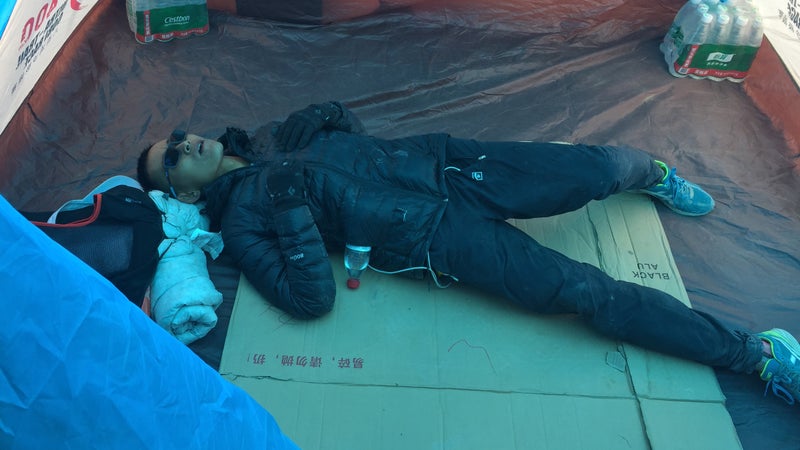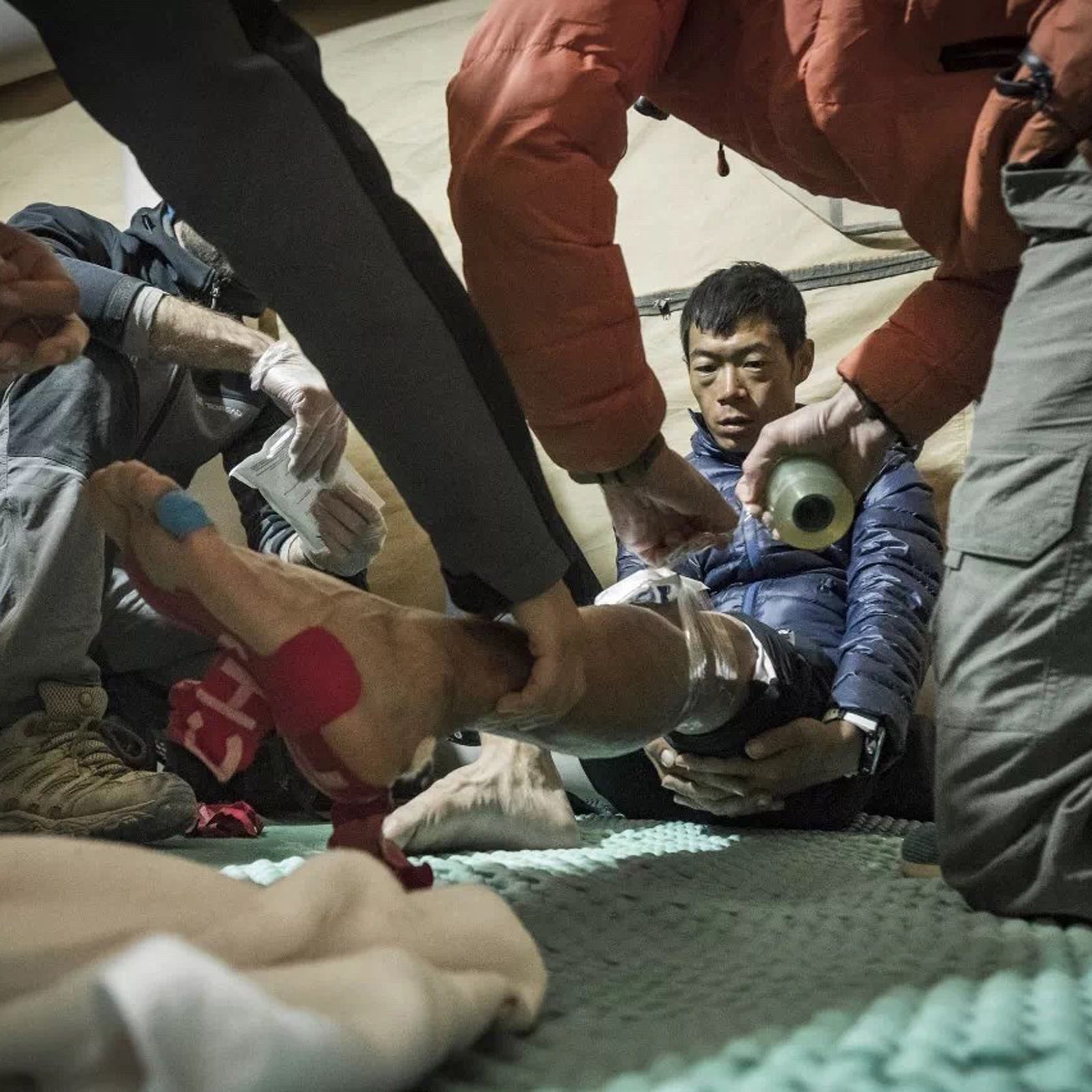On the third day of the╠ř, a 250-mile race in the vast Chinese desert in late September, elite British ultrarunner was hallucinating.╠řHeÔÇÖd gone more than a 130 miles, and a stretch of dirt road in an empty valley had suddenly became a parking lot jammed with cars, perhaps on a highway╠řor a rental lot at an airport. SomeoneÔÇöan attendant maybeÔÇöinformed him he had to return his car. But it was far away in the distance, so Montague╠řasked whether the attendant could return it for him. He╠řgrew more confused. The keys were no longer in his pocket, and hadnÔÇÖt he given them to the attendant? Then the parking lot disappeared, and Montague again found himself in the remote desert, with the northern edge of the Tibetan Plateau looming in the distance.
The previous night had been rough as well. After making his way down from the raceÔÇÖs high point at an elevation of over 13,000 feet, Montague arrived at a rest station shivering uncontrollably.╠řI was reporting at the Ultra Gobi, and╠řI╠řslept in media tents╠řat the rest stations, doubling up on sleeping bags and gauging the temperature, which could dip into the low teens at night after hitting daytime╠řtemperatures as high as 70 degrees, with plastic water bottles. When Montague arrived, the bottle╠řnext to my pillow had frozen solid. One of the doctors stationed at the rest point woke me, asking to borrow the extra bag. Montague was becoming╠řhypothermic, and James Poole, another British runner who arrived shortly after, was also at risk. The race leaders had been hallucinating as well when theyÔÇÖd come through a few hours before.

That night╠řthe two young British doctors,╠řRosemary Hartley and Nico Swetenham, made a rule. Anyone with a core body temperature below 96.8 degrees Fahrenheit, which they later lowered to 95,╠řwouldnÔÇÖt be allowed back onto the course. Inside the rest tent, Montague and Poole recovered in their bags and draped themselves in jun dayiÔÇöenormous, Mao-style green fur coats used by the Chinese army, which volunteers kept at the rest station. Their core temperatures╠řrecovered in a few hours, and the doctors let them go.
After a few days on the course, it was hard to imagine the event running╠řsafely without the doctors provided by , a British group founded in 2009 that provides medical services to remote adventure events all over the world. Xingzhi Exploring, the Chinese race organizer of the Ultra Gobi, had been required by the local government to hire a medical team. It was a large investmentÔÇöjust under $18,000ÔÇöand not one that most races make, which speaks to the moment in which ultraracing now finds itself: for the most part, itÔÇÖs still up to race organizers to decide how much medical support to provide, even as the sport has grown increasingly mainstream. Whether they should even have such standards, and how far they should go, are╠řunresolved questions.
ÔÇťI mean, itÔÇÖs not really good for you,ÔÇŁ the American ultrarunner Mike Wardian told me once, describing any race longer than 100 miles.
In a space where pushing limits is often the point, itÔÇÖs not clear how much medical support ultra organizers ought to provide. During competitions, ultrarunners experience (and assume the liability and risks for)╠řa wide range of medical challenges, ranging from blisters to hypothermia and heatstroke. In recent years, races have occasionally even seen╠řdeaths. Karl Hoagland, the publisher of UltraRunning╠řmagazine, has been tracking ultra-race╠řcompletions for a few decades and, according to his database, about 30,000 runners finished╠řultras in 2008. Last year, that number reached 110,000. With the uptick in participation, and more novices getting involved, questions surrounding standards of medical careÔÇöwhich thereÔÇÖs no global organization to setÔÇöare being asked more frequently.
In a space where pushing limits is often the point, itÔÇÖs not clear how much medical support ultra organizers ought to provide.
ÔÇťI donÔÇÖt believe there is a standard. The sport is growing up, and regulations for various aspects of race production are starting to come more front of mind. But who is the institute to put these regulations into place?ÔÇŁ says╠řlongtime ultrarunner╠řKrissy Moehl, who recently directed her first race in 17 years. ÔÇťThe medical piece is one of the discussions.ÔÇŁ
Hoagland agrees. ÔÇťI donÔÇÖt know of any formal standards of medical care for ultras,ÔÇŁ he says, adding╠řthat the sportÔÇÖs core values emphasize independent adventure, something╠řthat medical care should be careful not to spoil. In races, runners are expected to self-regulate, deciding when to rest, eat, or seek helpÔÇösometimes from other racers. ÔÇťThe ÔÇśnanny stateÔÇÖ regulates our daily lives to a great extent,ÔÇŁ Hoagland says,╠řÔÇťand ultras are a break from that. Trying to bring proactive, overinformed, and intrusive medical oversight to ultras is not practical or prudent, and it detracts from the sport.ÔÇŁ
Most athletes I spoke to╠řagreed with that sentiment, though with caveats. Montague feels the sweet spot falls╠řsomewhere in between allowing athletes to╠řmake decisions on their own until they enter a state where they may not be able╠řto do so by themselves. And thatÔÇÖs where good medical supervision should take over, he says,╠řproviding a kind of safety backup that doesnÔÇÖt cheat the experience of subjecting oneself to pain.
ÔÇťAs ultrarunners, weÔÇÖre exploring our limitations. But on any given day, these can be transient,ÔÇŁ Montague says. Exile Medics tries to manage this line delicately by being respectful of runnersÔÇÖ desire to push themselves, while helping them avoid unreasonable risks. By now╠řthe organization has had ten years of experience managing medical care with this balance in mind╠řat races all around the worldÔÇöChina, Namibia, Costa Rica, Sweden, Sierra LeoneÔÇöaveraging about 25 to 30 races per year. Brett Rocos, the founder and director of Exile Medics, says, ÔÇťOur experience means that we can tell between an exhausted, emotionally drained athlete and a person with genuine illness.ÔÇŁ Still, the medics╠řdo their best to let athletes make╠řdecisions about potential risk themselves, accepting╠řthat even as medical professionals they canÔÇÖt control all the dangers and making╠řsure runners know that. If a runner is hard-set on continuing despite╠řmedical issues, Exile Medics often lets them go, provided the ailment isnÔÇÖt extreme, like hypothermia.
A race with extremes that could so easily bring on hallucinations felt, at times, like it was╠řbordering on dangerous.
At the Ultra Gobi, Exile Medics navigated that line╠řwell. Later╠řMontague told me he might have gone back out prematurely that night if Exile Medics hadnÔÇÖt kept him insideÔÇöa doctorÔÇÖs order he now appreciates. But the team also let the athletes push themselves. After the race, I spent a lot of time interviewing runners about their hallucinationsÔÇöconversations, I admit, that I found comically entertaining in some cases. Seemingly everyoneÔÇöacross all races, nationalities, and sexesÔÇöleft reality at some point. Rocks turned into animals, abstract art appeared in the skies, family members showed up╠řout of nowhere, bushes transformed into giraffes. The visions frequently bordered on the magical, a kind of acid trip without the drug, and participants told me they deeply valued those experiences, untethered from the mundaneness of reality.
On the other hand, a race with such extremes felt, at times, like it was bordering on dangerous. , a participant╠řat previous Ultra Gobis, remarked that while most desert races felt like social walks with friends, the Ultra Gobi was a gauntlet. But with a trained medical team on the course, almost 80 percent of the runners completed the race.
Hoagland told me he expects the growth in ultrarunning to continue. And with it, pressure for race organizers to provide more medical supervision will likely also increase. But for a sport that pushes its athletes to extremes, expecting races to be held responsible for every health risk╠řis probably unreasonable. ÔÇťWith this sport becoming more mainstream, and more people than ever involved, the risks are greater,ÔÇŁ Montague says. ÔÇťSo both race directors and organizers have a greater degree of responsibility to negate these risks, to protect these individuals from themselves. But ultimately, the duty of responsibility needs to be taken by the athlete.ÔÇŁ
The Ultra Gobi, at least, seemed to strike the right balance. Before everyone departed, the Exile Medics staff shared beers on the rooftop of a local hotel with some of the athletes. The mood was jovial. Runners swapped stories of hallucinations and pain, recounting them now with laughter and awe. Around the table, athletes and medics alike shared a sense of accomplishment. I heard no regrets. On their walks to bathroom breaks, most participants were limping, but they would recover soon enough.


